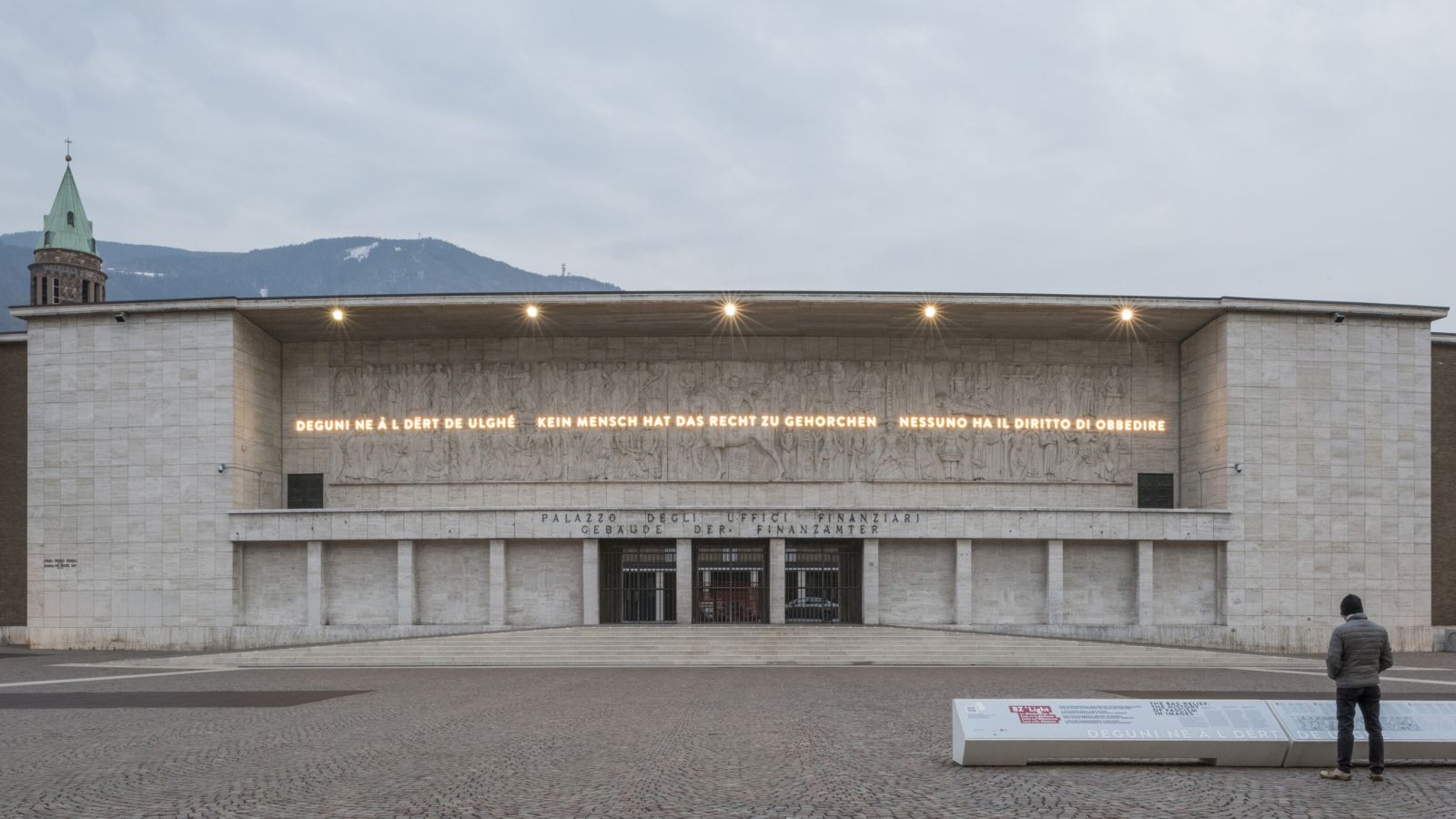Zoltán Somhegyi
Curing and Caring Through Art:
Memory and Memorials in Times of Changing
Interpretation of the Contested Past
Zoltán Somhegyi

Michele Bernardi and Arnold Holzknecht, Untitled, 2017, LED lights, installation on Hans Piffrader,
Il Trionfo del Fascismo, 1939–42, bas-relief, Palazzo delle Finanze, Bolzano (photograph by Laura Egger)
The past is not fixed, and actually it has never been stable. The interpretations and hierarchy of values change from time to time. Works and projects of art, especially monuments and memorials are particularly helpful, with which and through which one can relate to the past, and they are especially useful to tackle issues related to a contested and contaminated past, hence to encounter sensitive issues that otherwise would perhaps be even more difficult to confront.
There can be many inspiring aspects connected to monuments, including (1) the publicness of the work, (2) the modes and styles of confrontation with the past, or (3) the properties, including the aesthetic qualities of the piece etc. However, one of the questions that is particularly actual today is (4) the fate of the work, especially of (public) monuments and memorials.
In a classical sense, monuments are erected to commemorate certain events or personalities. However, this original intention and hence also the earlier “message” may change. For example, its relevance can fade, the historical, political or cultural significance of what the monument aims at maintaining nevertheless loses its importance in the eye of the later generations. It can become so also because of our overly optimistic hopes of the forces of this “externalized” act: we somehow think that once a monument is erected, we can fully rely on it to do its job, to keep the memory alive. However, it is often the contrary. Like, as Robert Musil famously stated in 1927, monuments are definable as “invisible”, claiming that their most noticeable characteristic is that of remaining unnoticed.
The curious part is that nevertheless even this “invisibility” is not fixed, just like anything else from the past. Recent debates on monuments and memorials, and, especially the demolishing and decommissioning or at least defacing of monument have shown that monuments can step out from the invisibility, and can ignite important discussions on the (re)interpretation of history or on stopping honoring figures and events that are no longer viewed as deserving of honor in the way that they may have seemed when the memorial was erected. The many contemporary discussions, among others stimulated by, for example BLM or #metoo, can all offer fertile theoretical background to continue reconsidering monuments, memorials as well as the modes of remembering through (public) art in general. What leads to an equally inspiring set of questions is the survey of the both theoretical and practical implications of these processes. Perhaps the most important of these is the question of what to do with these monuments? Leave them there? Demolish them? Let them stay as they are modified or defaced by the public, i.e. to let it become a new public monument by the new public? Or bring it to a museum, so that the monument becomes a monument not of the originally commemorated figure or event, but, on a meta-level, of the interpretation of history of a past epoch? One of the most interesting approaches – though it requires broad social consultation, as well as creativity and perhaps even some financial support – is to do something with and around the actual, original monument. I think a good example of this is Michele Bernardi’s and Arnold Holzknecht’s intervention in Hans Piffrader’s Mussolini frieze in Bolzano/Bozen in Italy. A very minimal intervention, leaving the original in its original space, nevertheless transforming it into a memorial of the controversies and tragic atrocities of Fascism and providing thought for reflection about the modes of avoiding its recurrence.
A similar direction could possibly point towards a solution that has at least the potential for fruitful discussions in an inclusive way, involving much of the society. If something similar could be stimulated around more and more of the controversial memorials, that could pave the way of expressing various approaches, offering multiple readings of a contested history and its commemoration, and thus finding modes of conciliation and reconciliation.
 Zoltán Somhegyi is Associate Professor of Art history at the Károli Gáspár University of the Reformed Church in Hungary, Budapest
Zoltán Somhegyi is Associate Professor of Art history at the Károli Gáspár University of the Reformed Church in Hungary, Budapest
Back to Meridian 4.png)

